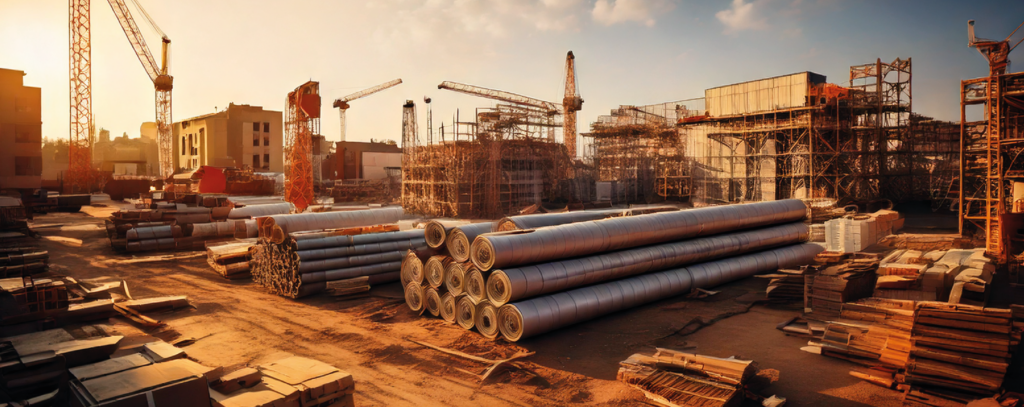What is Construction Productivity?
Construction Productivity is more than just a buzzword. It’s the lifeblood of any project, the deciding factor that can mean the difference between a resounding success and a financial headache. In the competitive world of building, have you ever wondered why some projects finish on time and on budget, while others drag on endlessly? The answer often lies in one key idea: efficiency.
If you’re an industry professional, a construction company owner, a site manager, or an architect, you’ve likely asked yourself why your projects aren’t progressing as fast as you’d hoped. Does the feeling of watching deadlines stretch and costs skyrocket sound familiar? You’re not alone.
The construction industry, vital for economic development, often faces challenges that slow productivity.
In this article, we’ll explore how productivity isn’t just a metric but a strategy to optimize every brick, every hour of work, and every machine. From Cemex Ventures, we’ll share 5 essential keys to transform the way you manage your construction projects and supercharge productivity.
Dive into this article full of tips!
Table of Contents
From the Stone Age to the Digital Age: Poor Planning is Your Worst Enemy
Did you know the first lesson in project management was learned the hard way in the Stone Age?
Imagine the first clans trying to build a stockade for protection. One of them, instead of choosing thick logs and setting them in solid ground, opted for thin branches and leaned them against the soft riverbank. The result: the first storm washed their “masterpiece” away without a trace, and they had to start from scratch.
This primitive example reminds us that, even in the age of technology, a bad choice during the planning phase can cause a project to literally disappear before it even begins.
An alarming 60% of construction projects suffer delays and cost overruns due to poor planning. For decades, the industry has clung to outdated, manual planning methods that are prone to error. The solution, however, is within our grasp: leveraging new solutions in the industry will significantly help us achieve more precise planning.
Building Information Modeling (BIM) is a perfect example. This technology allows you to visualize the project in 3D, detect design clashes, and optimize the construction sequence before a single brick is laid. By moving problems from the construction site to the office, you can save a significant amount of time and money. Additionally, project management software allows all team members to collaborate in real-time, efficiently allocate resources, and track progress from a single dashboard.

Ride the AI Wave: Artificial Intelligence Isn’t Just Science Fiction
Just as the T-800 famously promised in the iconic movie Terminator, “I’ll be back,“ artificial intelligence (AI) has delivered on that promise, not as an apocalyptic threat, but as a new and transformative reality.
In recent years, AI has evolved from a futuristic concept into an indispensable tool across various industries, and the construction sector is no exception.
Beyond Intuition: Data-Driven Decision-Making
Traditionally, on-site decision-making has often been based on the experience and intuition of seasoned professionals. While this wisdom is invaluable, it can also lead to costly mistakes and a lack of objectivity.
This is where AI steps in, not as a luxury but as a fundamental tool to optimize processes and enable smarter, data-driven decisions.
Key Applications of AI in Construction
AI is revolutionizing the industry in multiple ways:
Predictive Analytics: Using historical data from past projects, AI algorithms can accurately anticipate potential delays, unforeseen risks, and material needs. This enables project managers to shift from a reactive to a proactive approach, thereby mitigating problems before they occur.
Safety and Automation: Jobsite safety is a top priority, and AI enhances it significantly. AI-equipped drones monitor progress and detect deviations from the original plan, while robots automate repetitive and dangerous tasks like welding or heavy lifting. Furthermore, AI-powered safety systems can monitor the environment in real time to detect risks (such as the absence of personal protective equipment or the presence of intruders in high-risk zones) and alert workers instantly.
Design and Planning: Generative design software with AI can optimize architectural plans to maximize energy efficiency or minimize material waste, exploring thousands of options in minutes. This not only accelerates the design phase but also contributes to the sustainability of projects.
In short, AI is not here to replace construction professionals but to empower them, making jobsites more efficient, safer, and profitable than ever before.
Material Waste: Your Wallet and the Planet Will Thank You
Material waste is a global problem. It’s estimated that between 20% and 30% of construction materials are wasted on-site. This doesn’t just have a negative environmental impact; it also directly affects your profitability. Adopting Cleantech solutions is the answer.
Using sustainable materials, such as low-carbon concrete or recycled materials, not only reduces your carbon footprint but can also lead to long-term savings. Furthermore, using AI and inventory management software can help you predict exact material needs and drastically reduce waste. And let’s not forget the importance of waste management, with tools that help you sort and recycle construction waste.
Communication Disconnect: Traditional Methods Aren’t Enough
One of the main causes of project delays is a lack of effective communication among on-site teams, the office, and subcontractors. While useful, traditional methods aren’t enough to manage the complexity of a construction project. The solution is to implement specific communication and collaboration platforms for construction.
Mobile applications allow you to share plans, photos, reports, and updates in real-time, ensuring all team members have the most current information. Digital twins, which are virtual recreations of the project, allow all stakeholders to have a unified view of the progress. Finally, platforms that integrate data from BIM, project management, and inventory eliminate information silos and ensure a seamless workflow.

Human Talent: Training and Technology Are a Winning Team
Technology is a powerful tool, but without the right people to use it, its potential is wasted. Resistance to change and a lack of staff training can be a brake on the adoption of new technologies. That’s why investing in staff training and fostering a culture of innovation is crucial.
Offering Contech and Cleantech training to your workers will give them the skills they need to use new tools effectively. Additionally, you can create an incentive program to reward teams that achieve greater efficiency and productivity by using technology. Fostering a culture of innovation where experimentation and learning are valued is the best way to ensure your team is prepared for the future.
The technology is there, but are we preparing to use it?
Productivity in construction is no longer an option; it’s a necessity. Adopting technology isn’t an expense; it’s an investment that will allow you to reduce costs, shorten deadlines, and build more sustainably.
At Cemex Ventures, we are committed to finding and supporting the most innovative solutions. Join this movement and let us know about your solution or startup.

